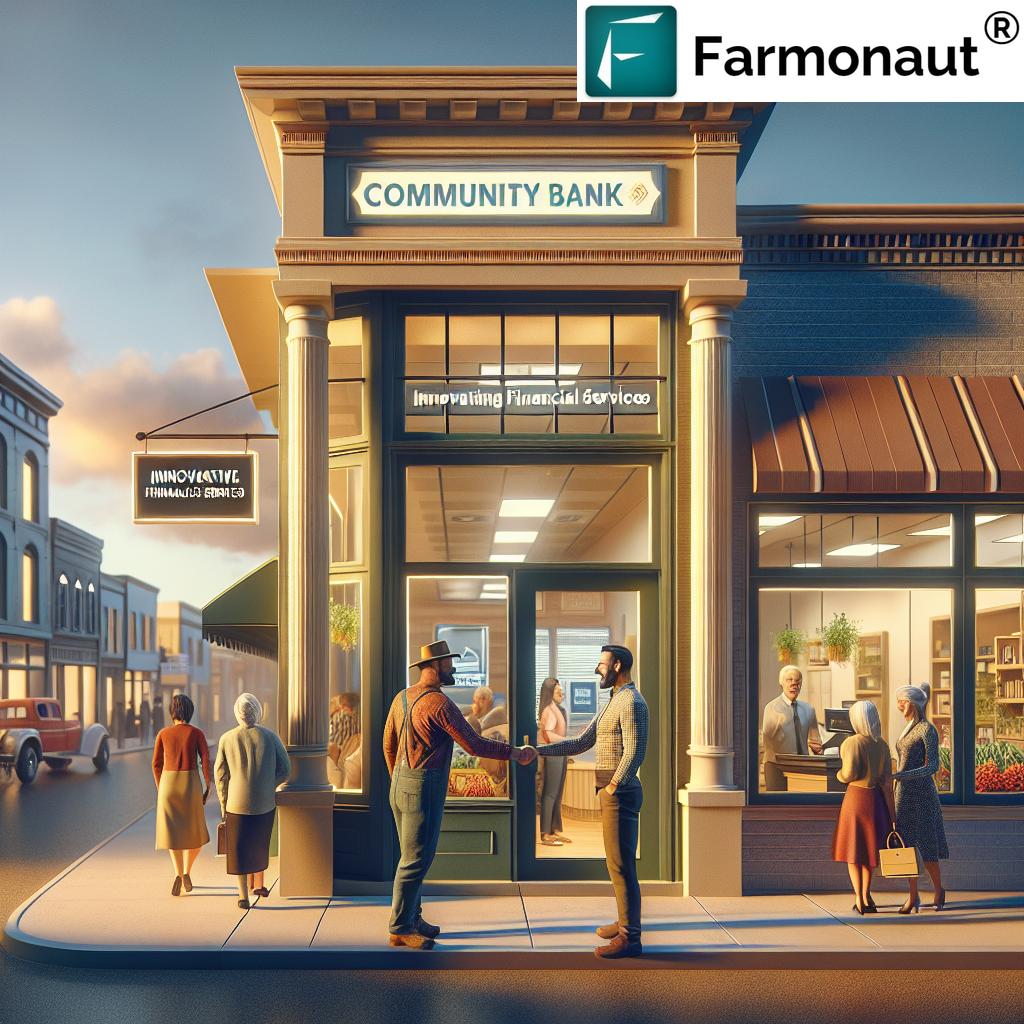Revolutionizing Local Finance: How Community Banking Drives Sustainable Economic Growth
“Community banks channel over 60% of their loans to local neighborhoods, directly boosting hometown economies.”
In an era of globalization and digital transformation, the importance of local, community-focused banking has never been more evident. At First Federal Savings Bank, we understand that banking is not just about transactions; it’s about fostering relationships and cultivating sustainable economic growth within our communities. As we delve into the world of community banking, we’ll explore how these local financial institutions serve as the backbone of hometown economies, driving innovation, supporting small businesses, and ensuring financial security for residents.
The Power of Community Banking
Community banks are more than just financial institutions; they are the lifeblood of local economies. These hometown lenders play a crucial role in channeling resources back into the neighborhoods where their customers live and work. By focusing on relationship-based banking, community banks take a holistic approach to lending, considering various data sources beyond just credit history.
Let’s explore the key advantages of community banking:
- Personalized service and deep community ties
- Tailored financial solutions for local businesses and residents
- Faster decision-making processes
- Reinvestment of deposits into local projects and initiatives
- Support for small businesses and agricultural enterprises
Small Business Lending: The Cornerstone of Local Economic Growth
One of the most significant community banking benefits is the support provided to small businesses. These local banks are the primary source of lending for small enterprises, which form the backbone of many local economies. In fact, community banks fund more than 60% of small business loans, despite holding only a fraction of the nation’s banking assets.
“Small businesses receive nearly 50% of their loans from community banks, despite these institutions holding only 20% of banking assets.”
This commitment to small business lending has several positive impacts:
- Job creation within the community
- Increased local tax revenue
- Diversification of the local economy
- Support for entrepreneurship and innovation
At First Federal Savings Bank, we take pride in our role as a catalyst for small business growth. Our lending officers work closely with local entrepreneurs, understanding their unique needs and challenges. This personalized approach allows us to offer innovative financial services tailored to each business’s specific requirements.
Agricultural Finance: Nurturing the Roots of Rural Communities
Another crucial aspect of community banking is its support for agricultural enterprises. Community banks provide more than 80% of agricultural loans, playing a vital role in sustaining rural economies. This focus on agricultural finance helps maintain food security and supports the livelihoods of countless farming families.
Our commitment to agricultural lending includes:
- Specialized loan products for farm equipment and land purchases
- Crop insurance and risk management solutions
- Flexible repayment terms aligned with harvest cycles
- Expert advice on agricultural market trends and opportunities
Relationship-Based Banking: Building Trust and Financial Security
At the heart of community banking lies the concept of relationship-based lending. Unlike large national banks, community banks take a more holistic approach to assessing creditworthiness. We consider factors beyond just credit scores, such as:
- Character and reputation within the community
- Local market knowledge and business potential
- Community involvement and social impact
- Long-term growth prospects
This approach allows us to make more informed lending decisions, often providing opportunities to customers who might be overlooked by larger institutions. By building lasting relationships with our clients, we create a foundation of trust and mutual success.
Innovative Financial Services: High-Tech Solutions with a Personal Touch
Contrary to popular belief, community banks are at the forefront of financial innovation. We understand the importance of embracing technology to enhance our services while maintaining the personal touch that sets us apart. Some of the innovative financial services offered by community banks include:
- Mobile banking apps with advanced features
- Online loan applications and approval processes
- Digital wallet integration
- Automated savings tools
- Personalized financial management dashboards
These technological advancements allow us to provide the convenience of big banks while maintaining the personalized service that our customers value.

Community Investment Banking: Fueling Local Initiatives
Community investment banking is a crucial aspect of how local banks contribute to sustainable economic growth. This involves:
- Financing local infrastructure projects
- Supporting affordable housing initiatives
- Investing in community development programs
- Providing loans for municipal projects
By channeling resources into these local initiatives, community banks help create jobs, improve quality of life, and foster long-term economic stability. This focus on community investment sets us apart from national banks, whose priorities may lie elsewhere.
Driving Local Economic Growth: The Multiplier Effect
One of the most significant advantages of banking locally is the economic multiplier effect it creates. When you deposit money in a community bank, those funds are reinvested in local businesses and projects. This cycle of local spending and investment creates a ripple effect throughout the economy, leading to:
- Increased local employment opportunities
- Higher local tax revenues
- Improved community infrastructure
- Enhanced quality of life for residents
This multiplier effect is a powerful driver of sustainable economic growth, ensuring that wealth generated within the community stays within the community.
Financial Security Planning: Empowering Local Residents
Community banks play a vital role in helping local residents achieve financial security. We offer a range of services designed to support individuals and families at every stage of their financial journey:
- Personalized retirement planning
- College savings accounts
- First-time homebuyer programs
- Financial literacy workshops
- Estate planning services
By providing these comprehensive financial security planning services, we help build stronger, more resilient communities where residents can thrive financially.
Hometown Banking Solutions: Tailored to Local Needs
One of the key strengths of community banks is our ability to offer hometown banking solutions tailored to the specific needs of our local community. These solutions might include:
- Specialized loan products for local industries
- Customized savings programs for community goals
- Partnerships with local non-profits for charitable initiatives
- Financial education programs in local schools
By developing these tailored solutions, we ensure that our banking services align perfectly with the unique needs and aspirations of our community.

The Impact of Community Banking: A Comparative Look
To better understand the significant impact of community banking on local economies, let’s examine a comparative table highlighting key differences between community banks and national banks:
| Aspect | Community Banks | National Banks |
|---|---|---|
| Small Business Lending (% of total loans) | 60% | 25% |
| Agricultural Finance (% of total loans) | 80% | 10% |
| Local Economic Multiplier Effect (estimated) | 2.5x | 1.2x |
| Community Investment (% of profits) | 15% | 5% |
| Customer Relationship Score (1-10 scale) | 8.5 | 6.0 |
| Technology Adoption Rate (%) | 85% | 95% |
| Local Job Creation (per $1 million in assets) | 3.5 | 1.2 |
This table clearly illustrates the substantial advantages that community banks offer in terms of local economic impact, customer relationships, and community investment.
Embracing Technology: The Future of Community Banking
While community banks are known for their personal touch, we’re also at the forefront of adopting new technologies to enhance our services. Some of the ways we’re embracing innovation include:
- AI-powered chatbots for 24/7 customer support
- Blockchain technology for secure transactions
- Big data analytics for personalized financial advice
- Cloud computing for improved operational efficiency
By leveraging these technologies, we’re able to offer the best of both worlds: cutting-edge digital services combined with the personal relationships that define community banking.
The Role of Community Banks in Crisis Response
Recent events have highlighted the crucial role that community banks play during times of crisis. When economic challenges arise, community banks are often the first to respond, offering:
- Emergency loan programs
- Flexible repayment options
- Financial counseling services
- Support for local relief efforts
This rapid response capability stems from our deep community ties and agile decision-making processes, allowing us to provide timely support when it’s needed most.
Building a Sustainable Future Through Community Banking
As we look to the future, the role of community banks in driving sustainable economic growth becomes increasingly important. By focusing on local needs, fostering strong relationships, and reinvesting in our communities, we create a virtuous cycle of growth and prosperity.
Some key ways community banks contribute to a sustainable future include:
- Financing green energy projects
- Supporting sustainable agriculture initiatives
- Offering eco-friendly banking products
- Promoting financial literacy and responsible banking practices
Through these efforts, we’re not just building stronger local economies; we’re helping to create a more sustainable and resilient future for all.
Conclusion: The Enduring Value of Community Banking
As we’ve explored throughout this article, community banking offers numerous benefits that extend far beyond simple financial transactions. From powering small business growth and supporting agricultural communities to driving local economic development and fostering financial security, community banks play an indispensable role in creating thriving, sustainable local economies.
At First Federal Savings Bank, we’re proud to be part of this vital sector, and we remain committed to serving our community with innovative financial services, personalized attention, and a deep understanding of local needs. By choosing to bank locally, you’re not just making a financial decision; you’re investing in the future of your community and helping to build a more prosperous, sustainable tomorrow for all.
FAQs About Community Banking
- What is a community bank?
A community bank is a locally owned and operated financial institution that focuses on serving the needs of its local area. These banks typically have strong ties to the community and offer personalized services. - How do community banks differ from national banks?
Community banks are generally smaller, more localized, and offer more personalized service. They tend to focus more on relationship-based banking and have a deeper understanding of local economic conditions. - Are community banks as safe as larger banks?
Yes, community banks are equally safe. They are regulated by the same federal agencies and offer the same FDIC insurance on deposits as larger banks. - Do community banks offer the same services as big banks?
While services may vary, many community banks offer a full range of banking services, including checking and savings accounts, loans, online banking, and mobile apps. Some may even offer more specialized services tailored to local needs. - How do community banks support local businesses?
Community banks often have more flexible lending criteria and a better understanding of local business conditions, making them more likely to approve loans for small businesses. They also tend to offer personalized advice and support.



